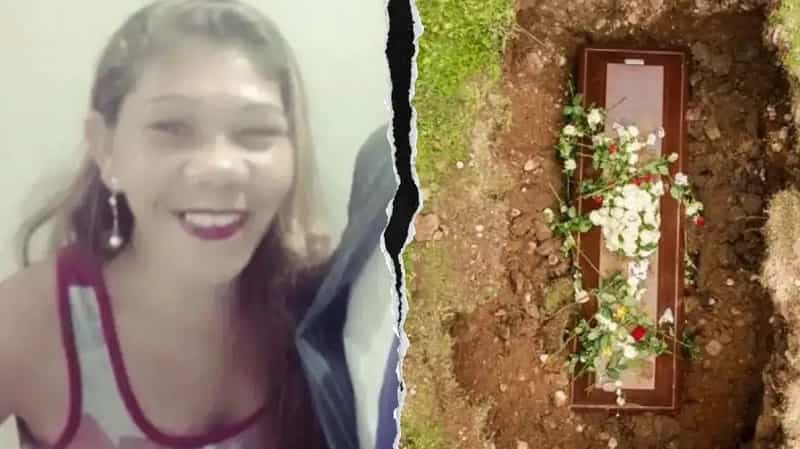BRAZIL: Woman spent 11 days trying to get out of coffin after being buried alive

In a heartbreaking incident that shocked the community of Riachão das Neves, a small town in northeast Brazil, a woman was mistakenly buried alive and spent 11 days fighting to escape her coffin.
Rosangela Almeida dos Santos, a 37-year-old woman, was declared dead and buried, but evidence suggests she was still alive when laid to rest. Her tragic story has left the town in disbelief and raised questions about the procedures followed during her burial.
The Shocking Discovery
Rosangela’s ordeal began when she was rushed to the Hospital do Oeste in Barreiras, Brazil, after suffering from severe fatigue. She spent a week in the hospital, where she experienced two cardiac arrests. Doctors declared her dead due to “septic shock,” and her family held a wake before burying her in a concrete tomb at the Senhora Santana cemetery in her hometown.
Eleven days after her burial, neighbors near the cemetery reported hearing strange noises, including screams and banging, coming from Rosangela’s tomb. Concerned, they alerted her family, who rushed to the cemetery to investigate. What they found was horrifying.
When the tomb was opened, Rosangela’s body was discovered in a different position than when she was buried. Her hands and forehead showed injuries, and there were scratches and blood inside the coffin. The cotton wool that had been placed in her ears and nostrils had fallen out, and the nails on the coffin lid were pushed upward, as if she had tried to force her way out. Her body was still warm, leading many to believe she had been alive for days after her burial.
A Desperate Struggle for Survival
Witnesses described the scene as chaotic and emotional. A video from the cemetery shows locals removing the heavy coffin and opening the lid. Some people touched Rosangela’s feet and commented on how warm she felt, while others called for an ambulance. Despite their efforts, she was declared dead at the hospital and reburied the next day.
Rosangela’s mother, Germana de Almeida, 66, spoke about the trauma of discovering her daughter’s injuries. She explained that Rosangela’s hands were wounded, and the coffin lid showed signs of being forced open. “She had tried to open the lid,” Germana said. “Even the nails that had been hammered in were loose. Her hands were injured, like she had been trying to get out.”
Neighbors also shared their experiences. Natalina Silva, a local housewife, recalled hearing muffled screams and banging from the tomb. At first, she thought it was children playing a prank, but the sounds grew more alarming. “I heard her groan twice,” Natalina said. “After those two groans, she stopped.”
A Community in Mourning
The incident drew hundreds of people to the cemetery, with more than 500 locals gathering to witness the shocking discovery. Ana Francisco Dias, a resident living near the cemetery, told Brazil’s Globo TV station that everyone who touched Rosangela’s body noticed she was still warm. “She wasn’t cold,” Ana said. “Everybody saw that she was still warm.”
Rosangela’s family is devastated by the tragedy. She was married but had no children and had struggled with health issues for most of her life. Since the age of seven, she had experienced fainting spells and took anticonvulsant medications to manage her condition. Her sudden death and the circumstances surrounding her burial have left her loved ones searching for answers.
Questions and Controversy
The incident has sparked outrage and raised serious questions about the medical and burial procedures in the region. How could someone be declared dead and buried while still alive? Could this tragedy have been prevented? These are the questions haunting Rosangela’s family and the community.
While the exact details of what happened remain unclear, the evidence suggests that Rosangela was alive when she was buried. Her injuries, the position of her body, and the state of the coffin all point to a desperate struggle for survival. The case has prompted calls for stricter protocols to ensure that such a horrifying mistake never happens again.
Rosangela’s story is a tragic reminder of the importance of thorough medical examinations and proper burial practices. It highlights the need for better training and resources in rural areas, where access to advanced medical care may be limited. For her family and the community of Riachão das Neves, the pain of losing Rosangela in such a horrifying way will take a long time to heal.
As the town mourns, they are left with haunting memories of the screams and banging that came from her tomb—a chilling reminder of the 11 days she spent fighting for her life. Rosangela’s story is one of unimaginable suffering, but it also serves as a call to action to prevent such tragedies in the future.
FAQs About the Tragic Case of Rosangela Almeida dos Santos
1. Who was Rosangela Almeida dos Santos?
Rosangela Almeida dos Santos was a 37-year-old woman from Riachão das Neves, a small town in northeast Brazil. She had a history of health issues, including fainting spells since childhood, and was taking anticonvulsant medications. She was married but had no children.
2. What happened to Rosangela?
Rosangela was declared dead after suffering two cardiac arrests and septic shock at the Hospital do Oeste in Barreiras, Brazil. She was buried in a concrete tomb at the Senhora Santana cemetery. Eleven days later, neighbors heard screams and banging from her tomb. When her coffin was opened, evidence suggested she had been buried alive and had tried to escape.
3. How did people find out she was buried alive?
Neighbors near the cemetery reported hearing screams and banging noises coming from Rosangela’s tomb. Her family was alerted, and when they opened the coffin, they found her body in a different position, with injuries to her hands and forehead. The coffin lid showed signs of being forced open, and her body was still warm.
4. What evidence suggested she was alive after burial?
- Her body was warm when the coffin was opened.
- She had injuries on her hands and forehead, indicating she had tried to escape.
- The cotton wool placed in her ears and nostrils had fallen out.
- The nails on the coffin lid were pushed upward, and there were scratches and blood inside the coffin.
5. Why was she declared dead if she was still alive?
Rosangela was declared dead at the hospital after suffering two cardiac arrests and septic shock. It is unclear whether there was a misdiagnosis or if she entered a coma-like state that was mistaken for death. The case has raised questions about the medical procedures followed.
6. What did her family say about the incident?
Rosangela’s family was devastated. Her mother, Germana de Almeida, said her daughter’s injuries were not present at the time of burial and that she had clearly tried to open the coffin. The family is seeking answers and justice for the tragic mistake.
7. How did the community react?
The incident shocked the community, with over 500 people gathering at the cemetery to witness the exhumation. Many were horrified by the evidence that Rosangela had been alive after her burial. The case has sparked outrage and calls for better medical and burial protocols.
8. What are the lessons from this tragedy?
This case highlights the importance of thorough medical examinations before declaring someone dead, especially in regions with limited access to advanced healthcare. It also underscores the need for better burial practices to prevent such horrifying mistakes.
9. Has anything changed since the incident?
While specific changes in the region are not widely reported, the case has prompted discussions about improving medical and burial procedures to ensure such tragedies do not happen again.
10. What happened to Rosangela’s body after the discovery?
After the coffin was opened and her body was examined, Rosangela was declared dead at the hospital and reburied the next day. Her family and the community continue to mourn her loss.
